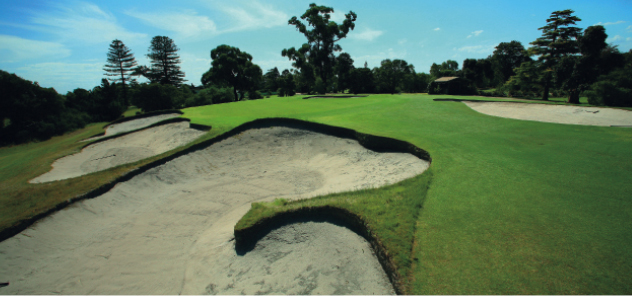
Long Island, arguably the most underrated course on the Melbourne sandbelt, deserves higher and wider acclaim. The sandy, undulating land where the course now lies began last century as Frankston Racecourse. And what a track it must have been, for the topography here is far from the flat terrain normally associated with the sport of kings.
Nearly 10 years after the last race was held, a developer came up with the idea of building a golf course next to the already established Peninsula club. The Great Depression put those plans on hold until 1933, when course designer Alex Russell – who’d worked with Dr Alister MacKenzie on Royal Melbourne’s West course and created the same club’s East course – was approached to assess the property.
His report was favourable, but Russell had reservations about the financial viability of the project. He said he could not spare the time to design the layout himself. The job went instead to Gordon Oliver, an expat Brit whose golf course design portfolio was at that stage empty. It is a testament to his raw ability that much of his creation, with the exception of three holes, went unaltered for decades. The trio of holes that did change – the 7th, 8th and 9th – were rebuilt by Vern Morcom in 1946. One of them now ranks among the best par-threes on the sandbelt.
Morcom replaced the par-five 9th because of its blind second shot. This resulted in a new par-four – the 8th, known as ‘Hogsback’ – and the 130-metre, par-three 9th, appropriately called ‘The Lookout’. Hogsback, a gentle 310 metres, is unique. The fairway is shaped like an actual hog’s back, so tee shots down the middle are channelled to the left or right edge of the fairway. Good club selection is required if you are to stay on the green, which slopes away from front to back.
The 9th is the shortest hole at Long Island. That makes it no less treacherous. The green is huge; the penalties for missing it, therefore, are stiff. Three deep bunkers line the putting surface to the left and there are another two to the right. Meanwhile a steep drop-off awaits anyone who hits too hard and sails over the back of the green. This hole traverses the highest point of the course, and on a windy day club selection can be the difference between par and a triple bogey.
Another well-named hole, ‘Dogleg’, opens the back nine and is a sandbelt classic. From the elevated tee, the hole plays much shorter than its 350 metres if you can tiptoe your drive past the edge of the bunker on the inside corner of the dogleg. Stray into the bunker and the best you will do here is make bogey. Find the fairway and a short iron into a receptive green gives you a shot at birdie.
Five strong par-fours close out the round. The longest and perhaps best of them, the 384-metre 17th, is known as ‘The Rise’. Thin strips of rough and thick clumps of ti-tree border both sides of the fairway, ready to inflict the ultimate penalty on the misguided drive. Ideally your tee shot should be played to the left half, which offers the best approach to an elevated green that slopes markedly from back right to front left. The scheme of bunkers to the right of the green causes most players to aim for the centre or left side, where the steep slope can feed your ball on to the fringe or into the greenside rough.
Long Island is a private club. Members of Golf Australia-affiliated clubs are able to apply for a tee time through the general manager.
|
MEMORABLE HOLES 5th, 8th, 9th, 10th, 12th and 17th WHERE TO GO Dandenong Rd, Frankston, Victoria 3199 BOOK A ROUND (03) 9786 4122, www.longislandgolf.com.au OTHER 120 GREAT COURSES NEARBY Peninsula (3.1 km), Settlers Run (12.4 km), Amstel (13.2 km) WHERE TO STAY Frankston is only a few minutes’ drive away. Within walking distance of Frankston beach are several motels, including the recently refurbished Frankston International Motel and Quest Frankston seaside resort. BEFORE/AFTER YOUR ROUND Frankston is the northern gateway to the Mornington Peninsula. From here, you can travel the region top to toe in 30 minutes. Go past quaint bathing boxes along the beachfronts of Dromana, Rosebud and Mornington, then head inland through the rolling hills where you’ll see orchards, market gardens and wineries. |
